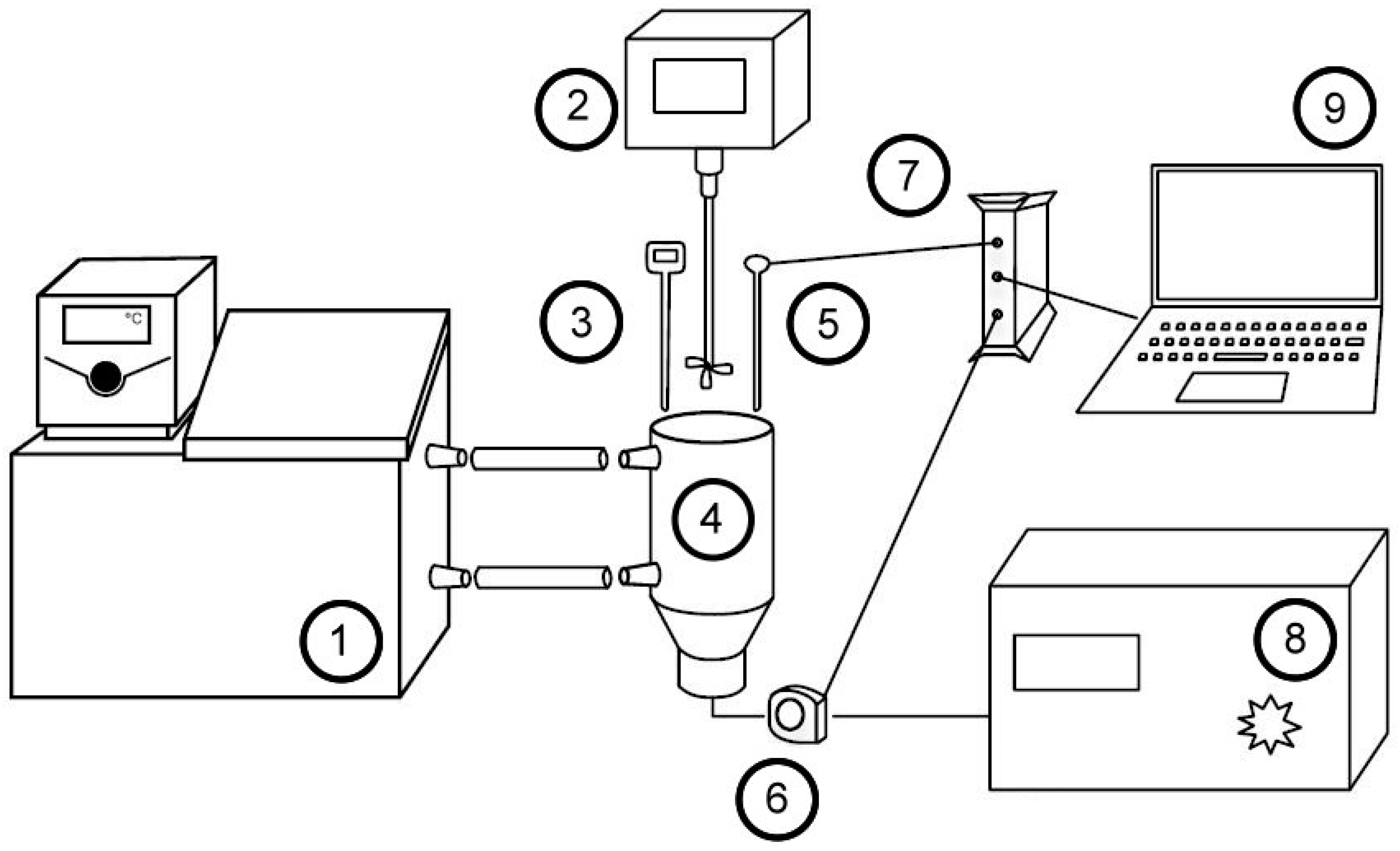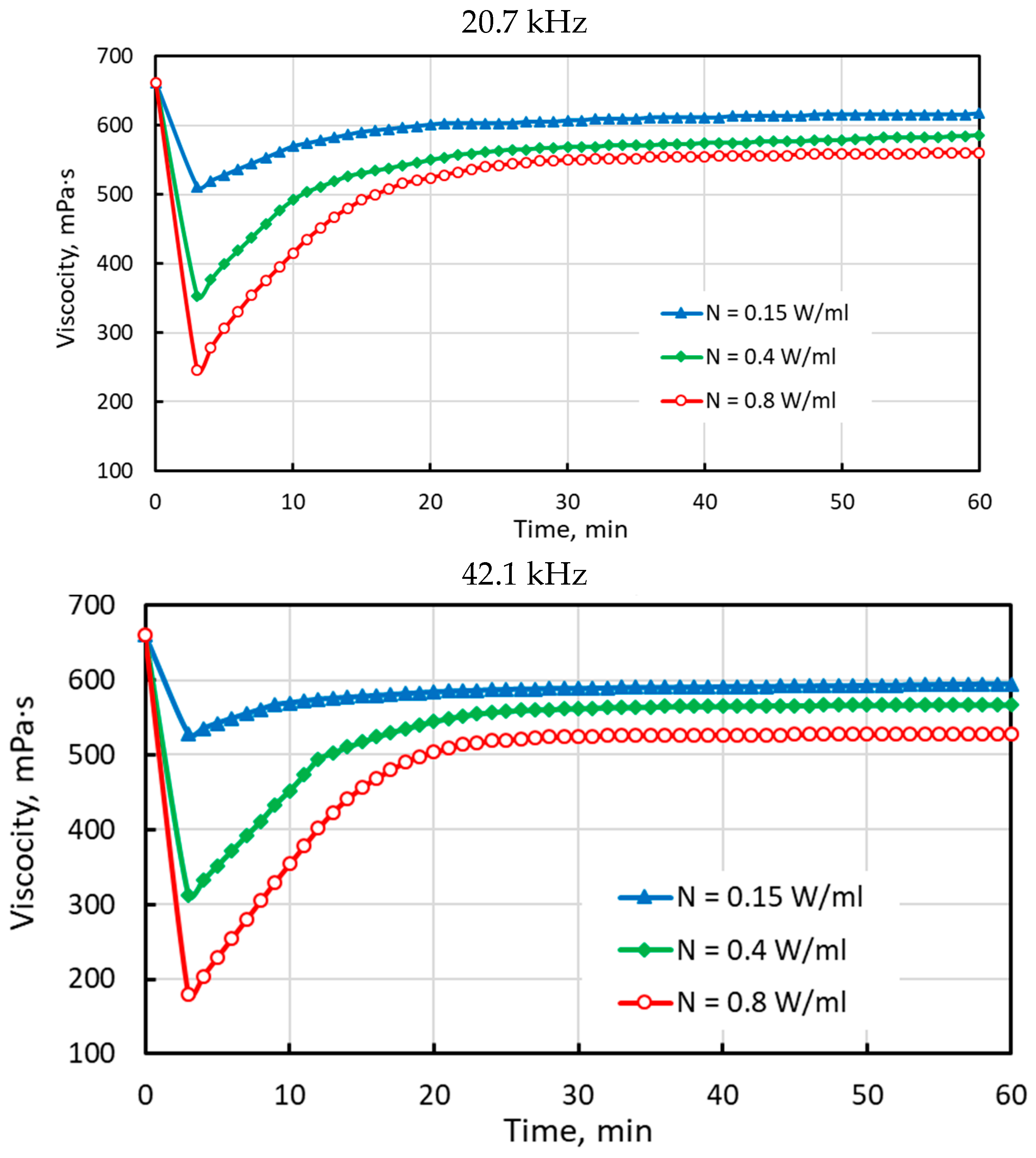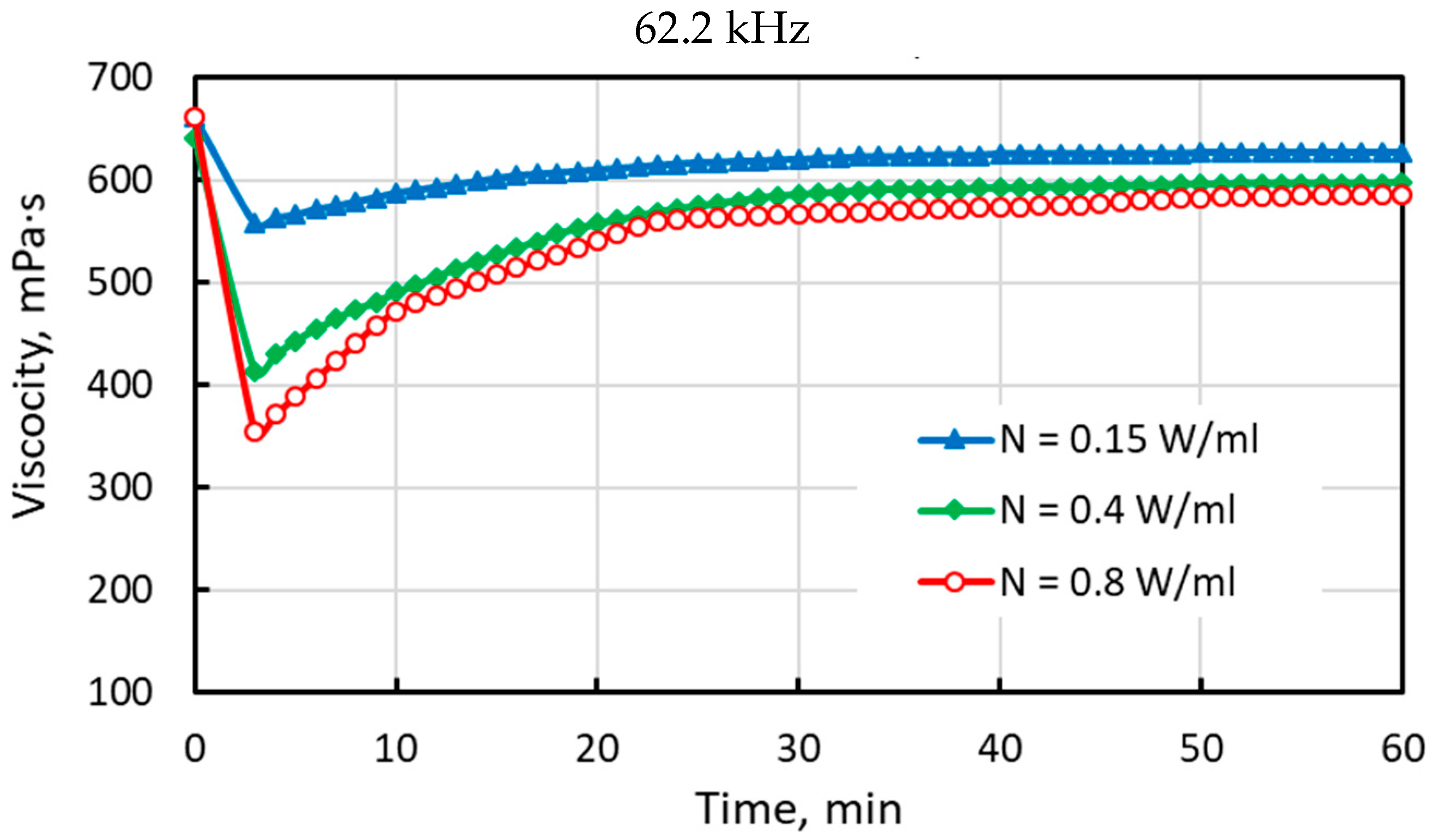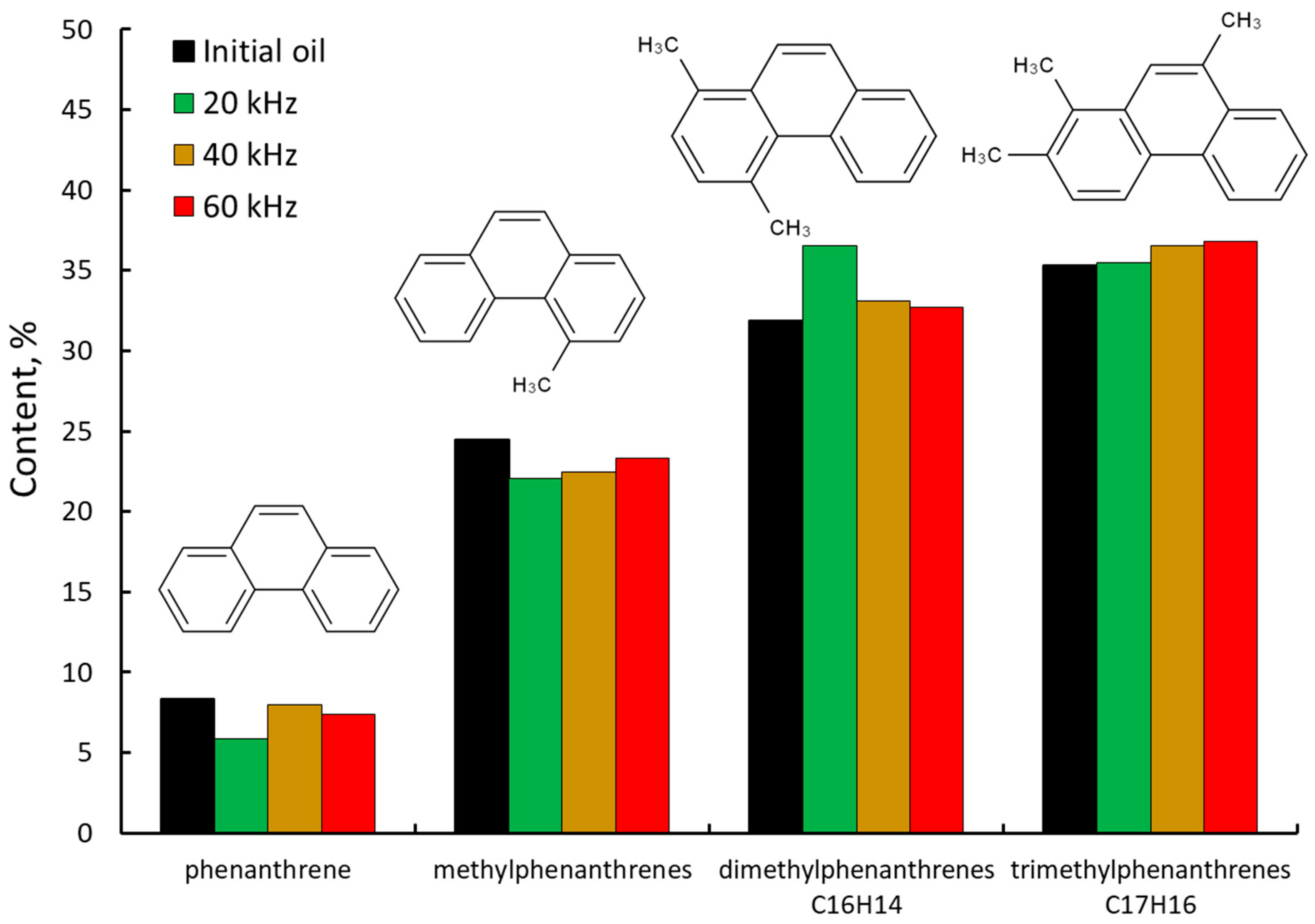Chemical Viscosity Reduction of Heavy Oil by Multi-Frequency Ultrasonic Waves with the Main Harmonics of 20–60 kHz
Abstract
1. Introduction
2. Materials and Methods
3. Results and Discussion
4. Conclusions
Author Contributions
Funding
Data Availability Statement
Conflicts of Interest
References
- Gately, D. A ten-year retrospective: OPEC and the world oil market. J. Econ. Lit. 1984, 22, 1100–1114. [Google Scholar]
- Rana, M.S.; Sámano, V.; Ancheyta, J.; Diaz, J.A.I. A review of recent advances on process technologies for upgrading of heavy oils and residua. Fuel 2007, 86, 1216–1231. [Google Scholar] [CrossRef]
- Li, H.; Wang, Q.; Wu, Y. Current Status and Development Direction of Low-Carbon Exploitation Technology for Heavy Oil. Energies 2023, 16, 2219. [Google Scholar] [CrossRef]
- Wu, Q. Acidic and basic catalytic cracking technologies and its development prospects for crude oil to chemicals. Fuel 2023, 332, 126132. [Google Scholar] [CrossRef]
- Gao, J.; Wu, P.; Li, C.; Xu, D.; Wang, X. Influence and Mechanism Study of Ultrasonic Electric Power Input on Heavy Oil Viscosity. Energies 2022, 16, 79. [Google Scholar] [CrossRef]
- Li, H.; Gao, H.; Zhao, X.; Xia, Z.; Yu, B.; Sun, D. Experimental study on viscosity reduction of heavy oil with water content by synergistic effect of microwave and nano-catalyst. J. Pet. Sci. Eng. 2022, 208, 109271. [Google Scholar] [CrossRef]
- Hasani, M.; Jafari, A. Electromagnetic field’s effect on enhanced oil recovery using magnetic nanoparticles: Microfluidic experimental approach. Fuel 2022, 307, 121718. [Google Scholar] [CrossRef]
- Mullakaev, M.S.; Abramov, V.O.; Abramova, A.V. Ultrasonic automated oil well complex and technology for enhancing marginal well productivity and heavy oil recovery. J. Pet. Sci. Eng. 2017, 159, 1–7. [Google Scholar] [CrossRef]
- Gondrexon, N.; Cheze, L.; Jin, Y.; Legay, M.; Tissot, Q.; Hengl, N.; Talansier, E. Intensification of heat and mass transfer by ultrasound: Application to heat exchangers and membrane separation processes. Ultrason. Sonochem. 2015, 25, 40–50. [Google Scholar] [CrossRef]
- Gondrexon, N.; Rousselet, Y.; Legay, M.; Boldo, P.; Le Person, S.; Bontemps, A. Intensification of heat transfer process: Improvement of shell-and-tube heat exchanger performances by means of ultrasound. Chem. Eng. Process. Process Intensif. 2010, 49, 936–942. [Google Scholar] [CrossRef]
- Marfin, E.A.; Gataullin, R.N.; Abdrashitov, A.A. Acoustic stimulation of oil production by a downhole emitter based on a jet-driven helmholtz oscillator. J. Pet. Sci. Eng. 2022, 215, 110705. [Google Scholar] [CrossRef]
- Sokolov, E.; Kaluzhnaya, D.; Shel’deshova, E.; Ryapolov, P. Formation and Behaviour of Active Droplets and Bubbles in a Magnetic Fluid in an Inhomogeneous Magnetic Field. Fluids 2023, 8, 2. [Google Scholar] [CrossRef]
- Bhasarkar, J.B.; Chakma, S.; Moholkar, V.S. Investigations in physical mechanism of the oxidative desulfurization process assisted simultaneously by phase transfer agent and ultrasound. Ultrason. Sonochem. 2015, 24, 98–106. [Google Scholar] [CrossRef]
- Hossain, M.N.; Choi, M.K.; Choi, H.S. A Review of the Desulfurization Processes Used for Waste Tire Pyrolysis Oil. Catalysts 2021, 11, 801. [Google Scholar] [CrossRef]
- Hossain, M.N.; Park, H.C.; Choi, H.S. A Comprehensive Review on Catalytic Oxidative Desulfurization of Liquid Fuel Oil. Catalysts 2019, 9, 229. [Google Scholar] [CrossRef]
- Gildo, P.J.; Dugos, N.; Roces, S.; Wan, M.W. Optimized Ultrasound-Assisted Oxidative Desulfurization Process of Simulated Fuels over Activated Carbon-Supported Phosphotungstic Acid. MATEC Web Conf. 2018, 156, 03045. [Google Scholar] [CrossRef]
- Jalali, M.R.; Sobati, M.A. Intensification of Oxidative Desulfurization of Gas Oil by Ultrasound Irradiation: Optimization Using Box–Behnken Design (BBD). Appl. Therm. Eng. 2017, 111, 1158–1170. [Google Scholar] [CrossRef]
- Margeta, D.; Sertić-Bionda, K.; Foglar, L. Ultrasound Assisted Oxidative Desulfurization of Model Diesel Fuel. Appl. Acoust. 2016, 103, 202–206. [Google Scholar] [CrossRef]
- Akbari, A.; Omidkhah, M.; Towfighi Darian, J. Facilitated and Selective Oxidation of Thiophenic Sulfur Compounds Using MoOx/Al2O3-H2O2 System under Ultrasonic Irradiation. Ultrason. Sonochem. 2015, 23, 231–237. [Google Scholar] [CrossRef]
- Choi, A.E.S.; Roces, S.; Dugos, N.; Futalan, C.M.; Lin, S.S.; Wan, M.W. Optimization of Ultrasound-Assisted Oxidative Desulfurization of Model Sulfur Compounds Using Commercial Ferrate (VI). J. Taiwan Inst. Chem. Eng. 2014, 45, 2935–2942. [Google Scholar]
- Yakovlev, В.А.; Zavarukhin, S.G.; Kuzavov, V.T.; Stebnovskiy, S.I.; Malikh, N.V.; Malsev, L.I.; Parmon, V.N. Investigation of chemical conversions of organic compounds under cavitation influence. Chem. Phys. 2010, 29, 43–51. [Google Scholar]
- Anufriev, R.V.; Volkova, G.I.; Vasilyeva, A.A.; Petukhova, A.V.; Usheva, N.V. The integrated effect on properties and composition of high-paraffin oil sludge. Procedia Chem. 2015, 15, 2–7. [Google Scholar] [CrossRef]
- Mieles-Gómez, L.; Lastra-Ripoll, S.E.; Torregroza-Fuentes, E.; Quintana, S.E.; García-Zapateiro, L.A. Rheological and Microstructural Properties of Oil-in-Water Emulsion Gels Containing Natural Plant Extracts Stabilized with Carboxymethyl Cellulose/Mango (Mangiferaindica) Starch. Fluids 2021, 6, 312. [Google Scholar] [CrossRef]
- Najafi, I.; Amani, M. Asphaltene flocculation inhibition with ultrasonic wave radiation: A detailed experimental study of the governing mechanisms. Adv. Pet. Explor. Dev. 2011, 2, 32–36. [Google Scholar]
- Shedid, A. An ultrasonic irradiation technique for treatment of asphaltenes deposition. J. Pet. Sci. Eng. 2004, 42, 57–70. [Google Scholar] [CrossRef]
- Anufriev, R.V.; Volova, G.I. Changes in the structure-mechanic parameters of hydrocarbons after high frequency acoustic infleunces. Chem. Terms Sustain. Dev. 2014, 22, 307–312. [Google Scholar]
- Anufriev, R.V.; Volkova, G.I. The change of the structural and mechanical properties of the hydrocarbons after high frequency acoustic irradiation. Chem. Sustain. Dev. 2014, 3, 307–312. [Google Scholar]
- Kuryakov, V.N. Influence of ultrasonic treatment on kinetic of asphaltene aggregation in toluene/heptane mixture. J. Phys. Conf. Ser. 2021, 1942, 012035. [Google Scholar] [CrossRef]
- Volkova, G.I.; Morozova, A.V. Structural transformations of bitumen asphaltenes after ultrasonic treatment. Solid Fuel Chem. 2022, 56, 133–137. [Google Scholar] [CrossRef]
- Avvaru, B.; Venkateswaran, N.; Uppara, P.; Iyengar, S.B.; Katti, S.S. Current knowledge and potential applications of cavitation technologies for the petroleum industry. Ultrason. Sonochem. 2018, 42, 493–507. [Google Scholar] [CrossRef]
- Hemmati-Sarapardeh, A.; Dabir, B.; Ahmadi, M.; Mohammadi, A.; Husein, M. Toward mechanistic understanding of asphaltene aggregation behavior in toluene: The roles of asphaltene structure, aging time, temperature, and ultrasonic radiation. J. Mol. Liq. 2018, 264, 410–424. [Google Scholar] [CrossRef]
- Klokova, T.P.; Volodin, Y.u.A.; Glagoleva, O.F. Effect of ultrasound on the colloidal-disperse properties of petroleum systems. Chem. Technol. Fuels Oils 2006, 42, 43–46. [Google Scholar] [CrossRef]
- Gafurov, M.R.; Volodin, M.A.; Rodionov, A.A.; Sorokina, A.T.; Dolomatov MYu Petrov, A.V.; Vakhin, A.V.; Mamin, G.V.; Orlinskii, S.B. EPR study of spectra transformations of the intrinsic vanadyl-porphyrin complexes in heavy crude oils with temperature to probe the asphaltenes' aggregation. J. Pet. Sci. Eng. 2018, 166, 363–368. [Google Scholar]
- Morozov, E.V.; Yushmanov, P.V.; Martyanov, O.N. Temperature-Triggered Rearrangement of Asphaltene Aggregates as Revealed by Pulsed-Field Gradient NMR. Energy Fuels 2019, 33, 6934–6945. [Google Scholar] [CrossRef]
- Derakhshesh, M.; Bergmann, A.; Gray, M.R. Occlusion of polyaromatic compounds in asphaltene precipitates suggests porous nanoaggregates. Energy Fuels 2013, 27, 1748–1751. [Google Scholar] [CrossRef]








| f, kHz | Parameter | W = 0.14 W/mL | W = 0.41 W/mL | W = 0.7 W/mL |
|---|---|---|---|---|
| 20.7 | ∆t (°C) | 1.1 | 3.5 | 7.4 |
| µsonication, mPa·s | 511.5 (↓ 22.6%) | 353.6 (↓ 46.5%) | 245.9 (↓ 62.8%) | |
| µplateau, mPa·s | 617.5 (↓ 6.6%) | 588.1 (↓ 11.1%) | 560.4 (↓ 15.2%) | |
| 42.1 | ∆t (°C) | 1.0 | 3.4 | 7.3 |
| µsonication, mPa·s | 527.4 (↓ 20.2%) | 312.0 (↓ 52.8%) | 178.8 (↓ 73.0%) | |
| µplateau, mPa·s | 595.5 (↓ 9.9%) | 567.1 (↓ 14.2%) | 528.9 (↓ 20.0%) | |
| 62.2 | ∆t (°C) | 1.2 | 3.6 | 6.8 |
| µsonication, mPa·s | 557.4 (↓ 15.7%) | 413.5 (↓ 37.5%) | 354.0 (↓ 46.5%) | |
| µplateau, mPa·s | 627.0 (↓ 5.2%) | 598.0 (↓ 9.6%) | 586.4 (↓ 11.3%) |
| Samples | Content, wt.% | |||||
|---|---|---|---|---|---|---|
| Saturates | Aromatics | Resins | Asphaltenes | Sum of Resins and Asphaltenes | ||
| Initial crude oil | 36.4 | 24.3 | 32.5 | 6.8 | 39.3 | |
| Sonicated crude oil samples | 20.7 kHz | 30.1 | 32.7 | 30.0 | 7.2 | 37.2 |
| 42.1 kHz | 28.6 | 34.1 | 29.4 | 7.9 | 37.3 | |
| 62.2 kHz | 24.1 | 32.7 | 34.2 | 8.9 | 43.1 | |
Disclaimer/Publisher’s Note: The statements, opinions and data contained in all publications are solely those of the individual author(s) and contributor(s) and not of MDPI and/or the editor(s). MDPI and/or the editor(s) disclaim responsibility for any injury to people or property resulting from any ideas, methods, instructions or products referred to in the content. |
© 2023 by the authors. Licensee MDPI, Basel, Switzerland. This article is an open access article distributed under the terms and conditions of the Creative Commons Attribution (CC BY) license (https://creativecommons.org/licenses/by/4.0/).
Share and Cite
Dengaev, A.V.; Kayumov, A.A.; Getalov, A.A.; Aliev, F.A.; Baimukhametov, G.F.; Sargin, B.V.; Maksimenko, A.F.; Vakhin, A.V. Chemical Viscosity Reduction of Heavy Oil by Multi-Frequency Ultrasonic Waves with the Main Harmonics of 20–60 kHz. Fluids 2023, 8, 136. https://doi.org/10.3390/fluids8040136
Dengaev AV, Kayumov AA, Getalov AA, Aliev FA, Baimukhametov GF, Sargin BV, Maksimenko AF, Vakhin AV. Chemical Viscosity Reduction of Heavy Oil by Multi-Frequency Ultrasonic Waves with the Main Harmonics of 20–60 kHz. Fluids. 2023; 8(4):136. https://doi.org/10.3390/fluids8040136
Chicago/Turabian StyleDengaev, Aleksey V., Aydar A. Kayumov, Andrey A. Getalov, Firdavs A. Aliev, Gadel F. Baimukhametov, Boris V. Sargin, Alexander F. Maksimenko, and Alexey V. Vakhin. 2023. "Chemical Viscosity Reduction of Heavy Oil by Multi-Frequency Ultrasonic Waves with the Main Harmonics of 20–60 kHz" Fluids 8, no. 4: 136. https://doi.org/10.3390/fluids8040136
APA StyleDengaev, A. V., Kayumov, A. A., Getalov, A. A., Aliev, F. A., Baimukhametov, G. F., Sargin, B. V., Maksimenko, A. F., & Vakhin, A. V. (2023). Chemical Viscosity Reduction of Heavy Oil by Multi-Frequency Ultrasonic Waves with the Main Harmonics of 20–60 kHz. Fluids, 8(4), 136. https://doi.org/10.3390/fluids8040136









